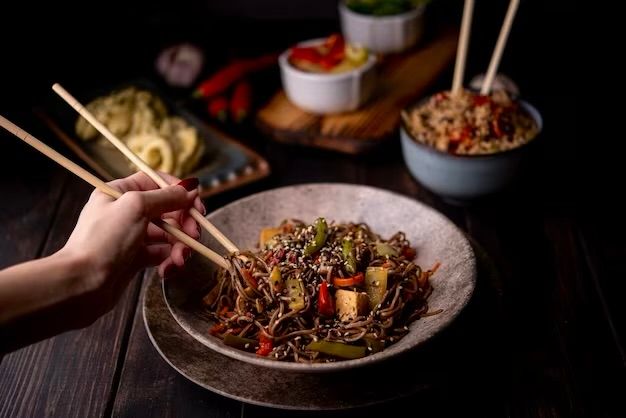Towards a Sustainable Future: Rethinking Global Nutrition and Embracing Insect Cuisine

Rethinking Nutrition: Humanity at a Crossroads
In the vast tapestry of human history, there have been moments that define generations, shape cultures, and redirect the course of civilization. Today, we stand at one such pivotal crossroads, not marked by a singular event, but by the culmination of countless decisions and actions that have brought us face to face with a global challenge: sustainability in nutrition.
The exponential growth of the global population, now numbering in the billions, has exerted immense pressure on our planet's resources. Forests have been cleared for agriculture, oceans overfished, and the environment burdened with the side effects of industrialized farming. Traditional food sources, once plentiful, are becoming scarcer, leading to rising food prices and insecurity in various parts of the world.
Furthermore, the environmental implications of our current food systems cannot be ignored. Livestock farming, in particular, has come under scrutiny for its contribution to greenhouse gas emissions, deforestation, and excessive water use. The ramifications are evident in the changing climate, unpredictable weather patterns, and the loss of biodiversity.
Parallel to these ecological challenges is the health crisis. Diets heavy in processed foods, red meats, and sugars have led to a surge in lifestyle diseases like obesity, diabetes, and heart ailments. The modern diet, for many, is not only unsustainable but also detrimental to health.
In the face of these intertwined challenges, a paradigm shift in how we view food and nutrition is imperative. The urgency to find sustainable, nutritious, and accessible food sources has never been greater. This isn't merely about individual choices but requires a collective reimagining of our food systems. The question looms large: How do we feed the billions without depleting the Earth?
Many believe the answer lies in diversifying our diets, reducing waste, and embracing innovations in food science. From vertical farming in urban centers to the exploration of alternative proteins like insects, algae, and lab-grown meats, the solutions are as varied as they are promising.
As we stand at this crucial juncture, it's clear that our choices today will determine the future of food, the health of our planet, and the well-being of generations to come. Rethinking nutrition isn't just a trend; it's a necessity, a global movement that beckons humanity to evolve, adapt, and thrive.
Cultures Where Insect Consumption Has Been a Tradition for Centuries
Insects have been a part of the human diet for millennia. Across the globe, various cultures have incorporated insects into their traditional meals, valuing them for their nutritional benefits and unique flavors. Here's an in-depth look at cultures where insect consumption has been a tradition for centuries.
1. Southeast Asia: A Hub of Edible Insects
In countries like Thailand, Cambodia, and Laos, it's common to find markets bustling with vendors selling an array of insects, from silkworm larvae to crickets. Thai street food, in particular, is renowned for its fried grasshoppers and bamboo worms, often seasoned with local spices.
2. Africa: Diversity in Insect Delicacies
Across the African continent, insects are harvested and consumed in various forms. In countries like Zambia, the protein-rich mopane worm is a culinary delicacy, often dried and cooked in a tomato-based sauce. Meanwhile, in Kenya, termites are collected during rainy seasons and fried or used in soups.
3. Mexico: Pre-Hispanic Culinary Traditions
Mexico boasts a rich history of insect consumption dating back to Aztec times. Today, dishes like 'chapulines' (grasshoppers) seasoned with chili and lime are popular in regions like Oaxaca. Agave worms, often found in mezcal bottles, are also consumed fried or as a taco filling.
4. Japan: Sophistication in Insect Cuisine
While not as widespread as in other Asian countries, certain regions in Japan value insects as a food source. In Nagano prefecture, for example, insects like silkworms and wasps are incorporated into traditional dishes, showcasing the intricate balance of flavors and textures.
5. Australia: Aboriginal Traditions
For Australian Aboriginal communities, the 'witchetty grub' holds cultural and nutritional significance. This wood-eating larvae is often roasted on coals and consumed, providing a rich source of protein and fats.
Benefits of Insect Consumption:
- Nutritional Value: Insects are packed with protein, essential amino acids, and vitamins, making them a nutritious alternative to traditional meats.
- Sustainability: With concerns about climate change and resource depletion, insects offer a more sustainable protein source, requiring less water, land, and food compared to livestock.
- Biodiversity: Thousands of insect species are edible, offering a vast range of flavors and textures to explore.
Challenges and Concerns:
While insect consumption offers numerous benefits, there are challenges to consider:
- Cultural Acceptance: In many Western cultures, there's a 'yuck' factor associated with eating insects, rooted in cultural norms and perceptions.
- Allergies: People allergic to shellfish may also react to insects due to similarities in proteins.
- Ethical Harvesting: As the demand for edible insects grows, ensuring they are harvested ethically and sustainably becomes paramount.
Insects have been an integral part of the human diet across various cultures for centuries. Their nutritional benefits, combined with their sustainability as a food source, make them an appealing option for the future. While there are challenges to address, the rich traditions rooted in insect consumption offer a glimpse into the culinary diversity and innovation that exists worldwide. As the global food landscape evolves, it's essential to recognize and value these age-old practices and consider how they might shape the future of food.
The Vast Edible Insect Spectrum: A World of Flavors and Textures
When we delve into the world of edible insects, the sheer diversity is astonishing. There are thousands of insect species that are considered safe and nutritious for human consumption. Each species offers a unique flavor, texture, and nutrient profile, making the realm of edible insects a rich tapestry of culinary experiences.
From the crunchy grasshoppers that are a popular snack in Thailand to the soft, buttery mopane worms relished in parts of Africa, the variety is extensive. Silkworm larvae, consumed in countries like Korea and Japan, have a chewy texture and a mild taste, while ants, especially in regions of South America, can add a tangy zest to dishes due to their formic acid content.
Beyond flavor and texture, the nutritional benefits of different insect species also vary. While crickets are often highlighted for their high protein content, other insects like mealworms offer substantial amounts of fiber and healthy fats. Beetles, which constitute the largest group of edible insects, come in various sizes and flavors, and they're consumed in numerous ways across different cultures – from being roasted to ground into powders.
Moreover, the way these insects are prepared and seasoned can transform their taste and appeal. The same insect might be a crunchy snack when fried, a savory ingredient when stewed, or a sweet treat when coated in chocolate.
In essence, the vast array of edible insect species presents a world of possibilities for chefs, food enthusiasts, and those seeking sustainable and nutritious food alternatives. Embracing this diversity not only expands our palate but also offers a more environmentally friendly approach to sourcing protein and other essential nutrients.
Edible Insects in the Nordic Region: A Sustainable Food Frontier
The Nordic countries, including Estonia, are known for their forward-thinking approaches to sustainability and food innovation. As global awareness of the environmental impacts of traditional livestock farming grows, there's an increasing interest in alternative protein sources. Edible insects, with their low ecological footprint, high nutritional value, and efficiency in converting feed into protein, emerge as a promising alternative for the Nordic region.
Potential Edible Insects for the Nordic Region
- Mealworms: These are among the most widely researched insects for human consumption. Their nutty flavor and versatility make them suitable for various dishes, from baked goods to main courses.
- Crickets: Already popular in many parts of the world, crickets could be easily integrated into Nordic diets. They can be ground into flour for bread and pastries or consumed whole as a crunchy snack.
- Black Soldier Fly Larvae: This insect is especially intriguing for its waste-reducing properties. They can consume organic waste, turning it into high-quality protein.
- Woodlice: Found abundantly in the region, woodlice are rich in protein and minerals. They can be prepared in ways similar to shrimp or small crustaceans.
Why Estonia and Other Nordic Countries Should Consider Insect Consumption
- Sustainability: Traditional livestock farming is resource-intensive, contributing significantly to greenhouse gas emissions, deforestation, and water consumption. Insects require less water, land, and food to produce the same amount of protein as cattle or poultry.
- Nutrition: Insects are packed with essential nutrients, including protein, omega-3 and omega-6 fatty acids, vitamins, and minerals. They can help diversify and enrich the Nordic diet.
- Economic Opportunity: The Nordic region has the potential to become a leader in insect farming and processing, creating new industries and job opportunities.
- Cultural Evolution: Just as sushi, once unfamiliar in the West, has become widely accepted, so too can insect dishes. Through culinary innovation, Nordic chefs can develop insect-based dishes that resonate with local tastes and traditions.
In conclusion, if the Nordic countries, including Estonia, aim to be at the forefront of sustainable living and tackle global challenges like climate change and food security, integrating edible insects into the diet might be one of the paths forward. By adopting this ancient practice with modern sensibilities, the region can set a precedent for the rest of the world in sustainable dining.



Comments ()